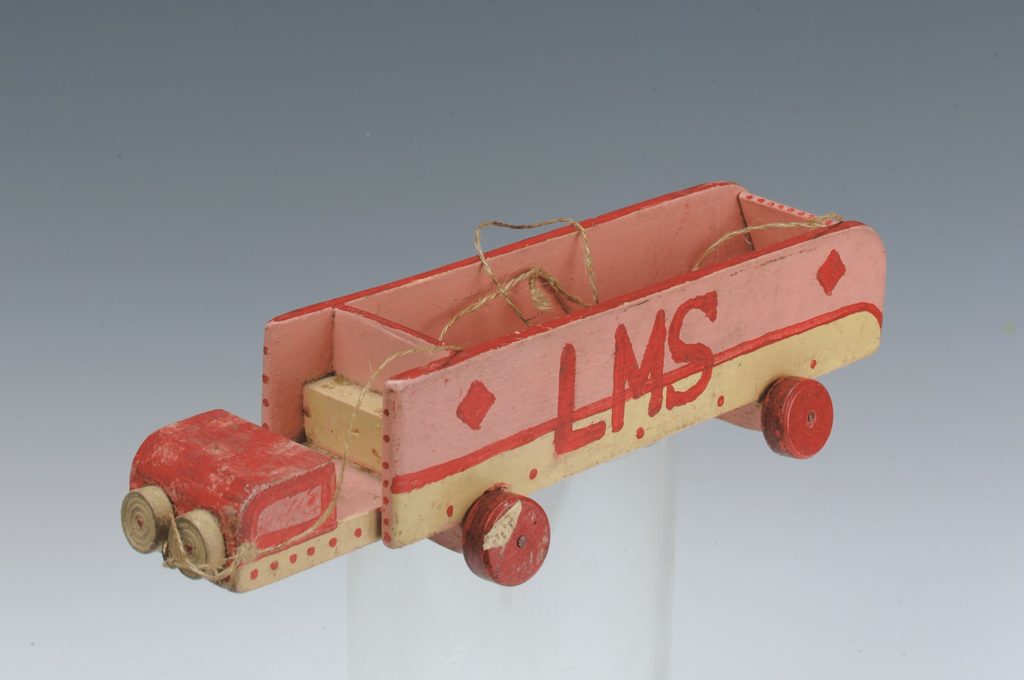Barney Greenman’s toy truck back in London: History of a loan

In 2017 the Jewish Museum was approached for the loan of a special object in the collection: the toy truck that Holocaust survivor Leon Greenman made for his toddler son Barney from scraps of wood during the Second World War. It was going to be shown in a temporary exhibition entitled ‘Auschwitz. Not long ago. Nor far away’ in Madrid.
For the museum team this was not a straightforward decision: Barney’s truck is one of the very few items on permanent display that tell the tragic history of Leon, a hairdresser from London, his wife Else and their son Barney. The family lived in the Netherlands during the Nazi occupation. Left without their papers that might have spared them as UK citizens, they were sent to Auschwitz, where Else and Barney were killed upon arrival. Leon survived several concentration camps and on his return to the UK dedicated a large part of his life telling his story and campaigning against antisemitism and racism. He worked with the education team of the Jewish Museum until he was in his nineties, and what he left behind forms the museum’s Holocaust Gallery.
The truck is a key object in the display; it represents the Greenmans’ family life before the Holocaust and it is an emotive reminder of Barney’s horrific death. Yet, the museum eventually decided in favour of the loan. Those who had known Leon were convinced that this would have corresponded with his wishes to tell the history of the Holocaust to as many people as possible. And the Spanish exhibition did, in fact, reach more than 600,000 visitors in the course of little over a year.
The exhibition is ambitious. It looks at the Holocaust through the prism of Auschwitz. In about 20 galleries lined with text panels and quotes along the walls it explores the rise of Nazism and the increasing exclusion of Jews from society, and it shows the plans behind Auschwitz and other concentration camps as well as the harrowing day-to-day reality in that place. It leaves nothing out including the accounts by members of the Sonderkommandos, those, mostly Jewish, inmates who were charged with the task of administering the cremation of the dead bodies of their fellow inmates, and it contains many graphic drawings made by survivors. I was wondering how the many children in the exhibition deal with what they see. The comprehensiveness and detail means that a visit is physically and psychologically draining.
The exhibition contains a lot of factual detail of the workings of the death camp, but it also tells the history of individual people. For instance the history of Jewish resistance, from the many ways in which inmates helped each other by organising food, giving shelter and keeping up morale in the most desperate situations, to collaborating with the armed Resistance or by organising their own uprising. It also reflects on the perpetrators, for example by showing pictures that illustrate the shockingly ‘normal’ life of camp overseers and commandants led within reach of their crimes. The experiences of the victims are told in several places throughout the exhibition in oral histories, diaries and memoirs and also through objects. A lonely children’s shoe with its sock tucked into it and a small heart-shaped booklet made for an inmate’s 20th birthday by her friends do not allow visitors to forget that they were individuals and not just part of an anonymous mass of victims.
The exhibition closed recently and will go on tour later this spring, starting at the Jewish Heritage Museum in New York. However, Barney’s truck will not be shown there. Instead, a facsimile of it will tell Leon’s Else’s and Barney’s story in the exhibition while the original is once again united with Else’s wedding dress and the other items that Leon kept to remind the world of what happened to his family, to six million Jews and all the other victims of the Holocaust.